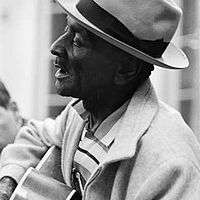Mance Lipscomb
| Mance Lipscomb | |
|---|---|
 | |
| Background information | |
| Birth name |
Beau De Glen Lipscomb or Bowdie Glenn Lipscomb |
| Born |
April 9, 1895 Navasota, Texas, United States |
| Died |
January 30, 1976 (aged 80) Navasota, Texas |
| Genres | Blues, Folk |
| Years active | 1960–1976 |
Mance Lipscomb (April 9, 1895 – January 30, 1976)[1] was an American blues singer, guitarist and songster. Born Beau De Glen Lipscomb[nb 1] near Navasota, Texas, United States, he as a youth took the name of 'Mance' from a friend of his oldest brother Charlie ("Mance" being short for emancipation).
Biography
Lipscomb was born April 9, 1895, to an ex-slave father from Alabama and a half Native American (Choctaw) mother.[4][5] Lipscomb spent most of his life working as a tenant farmer in Texas and was discovered and recorded by Mack McCormick and Chris Strachwitz in 1960 during the country blues revival. He released many albums of blues, ragtime, Tin Pan Alley and folk music (most of them on Strachwitz' Arhoolie label),[1] singing and accompanying himself on acoustic guitar. He had a "dead-thumb" finger-picking guitar technique, and an expressive voice. Lipscomb often honed his skills by playing in nearby Brenham, Texas, with a blind musician, Sam Rogers. His debut release was Texas Songster (1960). Lipscomb performed old songs like "Sugar Babe," the first song he ever learned, to pop numbers like "Shine On, Harvest Moon" and "It's a Long Way to Tipperary".[6]
Trouble in Mind was recorded in 1961 and released by Reprise Records.[7] In May 1963, Lipscomb appeared at the first Monterey Folk Festival in California.[8]
Unlike many of his contemporaries, he did not record in the early blues era, but his life is well documented thanks to his autobiography, I Say Me for a Parable: The Oral Autobiography of Mance Lipscomb, Texas Bluesman, narrated to Glen Alyn, which was published posthumously, and also a short 1971 documentary by Les Blank, A Well Spent Life.[1]
He began playing guitar early on and played regularly for years at local gatherings, mostly what he called "Saturday Night Suppers" hosted by someone in the area. These gatherings were hosted regularly for a while by himself and his wife. The majority of his musical activity took place within what he called his "precinct", meaning the local area around Navasota, until around 1960.
Following his discovery by McCormick and Strachwitz, Lipscomb became an important figure in the folk music revival of the 1960s. He was a regular performer at folk festivals and folk-blues clubs around the United States, notably the Ash Grove in Los Angeles, California.
He died in Navasota in 1976, two years after suffering a stroke.
Film
- A Well Spent Life (1971). Documentary directed by Les Blank and Skip Gerson. El Cerrito, California: Flower Films. Released on video in 1979. ISBN 0-933621-09-4.
- He also appeared in Blank's The Blues Accordin' to Lightnin' Hopkins (1970)
Honors
An annual Navasota Blues Festival is held in his honor, and on August 12, 2011, a bronze sculpture of him was unveiled in Mance Lipscomb Park in Navasota. The statue was sculpted by artist Sid Henderson of California and weighs almost 300 pounds. It portrays Lipscomb playing his guitar whilst seated on a bench, with room for fans to sit beside him and play their own guitars "with" him.
See also
Notes
References
- 1 2 3 "Mance Lipscomb Biography". OLDIES.com. 1976-01-30. Retrieved 2015-09-08.
- ↑ Eagle, Bob; LeBlanc, Eric S. (2013). Blues - A Regional Experience. Santa Barbara: Praeger Publishers. p. 363. ISBN 978-0313344237.
- ↑ Mance Lipscomb Discography, Wirz.de
- ↑ "Mance Lipscomb". Amazon.com. 2009. Retrieved 2009-07-15.
- ↑ "Bigg Boss 8 Official Website, Biggest Reality TV Show on Colors TV, Full Episodes Video, Live Videos, Mini Clips, Photo Gallery - Colors TV Show". Connect.in.com. Retrieved 2015-09-08.
- ↑ Russell, Tony (1997). The Blues: From Robert Johnson to Robert Cray. Dubai: Carlton Books Limited. p. 136. ISBN 1-85868-255-X.
- ↑ Cub Koda (1976-01-30). "Mance Lipscomb | Biography". AllMusic. Retrieved 2015-09-08.
- ↑ Tobler, John (1992). NME Rock 'N' Roll Years (1st ed.). London: Reed International Books Ltd. p. 120. CN 5585.
External links
- Illustrated Mance Lipscomb discography
- Lipscomb at Famoustexans.com
- Pictures of Mance Lipscomb and his Autobiography